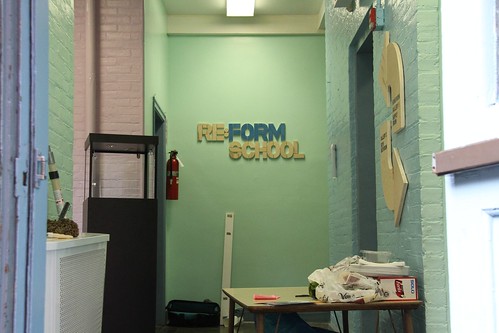Earlier today,
@DianeRavitch tweeted "Children arrive in kindergarten with gaps between them, based on family income, engagement. Teachers didn't cause that gap."
A short time later,
Aaron Thiell (@althiell) tweeted "@DianeRavitch Kindergarten should be a year of bedtime stories savored among new friends, not DIBELS nonsense word fluency & stop watches."
Diane Ravitch's main point may be that teachers are not to blame for poverty and other outside factors that cause children to lag behind in school, and thus they should not be blamed for student's failure to perform on high-stakes tests. But DIBELS are not high-stakes tests. In fact, DIBELS and other curriculum based measurements are some of the only academic tools teachers have to close the the achievement gap.
Like Diane Ravitch tweeted, teachers can't be blamed if students come to their classrooms without the prerequisite skills needed for success in school. We can't be blamed if students come to school hungry, sleep-deprived, or emotionally scarred any more than we can take credit if they enter our classrooms already able to perform at or above proficiency. All kids are different when they enter our classrooms, and that difference is probably the single-most challenging part of classroom teaching. It is impossible for teachers to ensure that all students enter our classrooms with the equal access to basic needs. It is impossible for us "to fix" the many environmental and genetic factors that predict success in school. The only thing we can control is how we teach.
How do we know how to teach when every student comes to us with a different set of abilities? There are two main ways:
- We can try to get to know each student by talking to them and closely examining their work. We can build individual relationships with each child that are so strong that we recognize when they are at frustration level, when they are confused, or when they are understanding concepts so well that they are ready to move on.
- We can use curriculum-based measurements (like DIBELS) to get quick and easy measurements of a students reading, writing, or math levels and take the guesswork out of figuring out what skills the student has when they enter our classrooms.
Option number one is really only plausible in a classroom with few students and a lot of time available for one-on-one instruction. Option number two is plausible anywhere. When curriculum-based measurements are used correctly, they eliminate the negative effects of outside factors over which teachers have no control.
Here's a hypothetical example:
J.D. is a third grade student who comes to school hungry and tired. His mom is a single parent who works 2 part-time jobs but still doesn't make enough money to support her four children. They live in a low-income housing complex that is riddled with crime. J.D.'s two oldest siblings have dropped out of school, and unless something changes J.D. and his younger sister will end up doing the same. His classroom teacher has been trying to help J.D. be successful, but she can't seem to get through to him. He is easily frustrated in class and as a result he has a lot of behavior issues. She thinks about what would make J.D. successful: a two-parent household, higher wages for his mother, a nicer place to live, positive role-models in his neighborhood. She feels helpless because she can't do anything about those things. It's not her fault J.D. is failing and there is no way for her to help him. She worries because there is no way to get J.D. to perform at grade-level on high-stakes tests when he comes from such an impoverished background. As a result of circumstances that are beyond her control, she may lose her teaching job.
In this hypothetical situation, the teacher is right: there is no way to help J.D. if we blame all of his problems on things that are happening outside of school and beyond our control. We can refer him to social services and send him to a breakfast program before school, but there is still a chance that his family won't follow through on obtaining any of those services. Does that mean that J.D. is unteachable? That we should give up? That his situation is so bad that he will never be able to learn?
ABSOLUTELY NOT. Scores of people have overcome situations of poverty to become successful. Teachers need to stop feeling helpless and use the tools that available to us to teach our students, no matter what skills or deficiencies they enter the classroom with. How can we do that? Using curriculum-based measurement (CBM) is a really good option.
Unlike high-stakes testing, CBM is what it stands for: measurement that is based on the curriculum. Students are assessed on skills they've actually been learning in the classroom, not on skills that a corporate test-maker decided all third graders should know. CBM allows a teacher to quickly find out what skills a student has when they enter her classroom by giving one or two-minute assessments in content areas such as reading or math. When a student's current level is assessed, the teacher can gear instruction for that level. Repeat measurements can be done weekly, monthly, or quarterly to monitor progress and then adjust the level of instruction if necessary. There is no guessing about what level a student is performing at or worrying about why they are at that level--teachers simply use current information to make decisions about instruction. When using CBM properly, teachers only have to worry about things over which they actually have control--how they teach and what level of curriculum they use with each student to do that teaching. I
can't adjust a student's home life; I
can adjust my instructional decisions.
Here's another possibility in the hypothetical situation of J.D. and his teacher:
J.D. still comes from the same situation of poverty. His teacher still wishes that there was something she could do to make his life easier. She brings snacks for her class each day so that they at least have a full belly when school starts. Within the first month of school she administers a reading probe (like DIBELS) to each of her students to see what their current reading level is. She spends a little over ten-minutes with J.D. to find out his instructional level in Oral Reading Fluency (ORF.) She discovers that despite the fact that J.D. is in third grade, he is barely reading at a first grade level. She adjusts her instruction so that J.D.'s reading group materials fit his level and he receives one-on-one instruction using first grade reading passages. The passages are challenging for J.D., but he's not so frustrated that he has behavioral outbursts. His teacher graphs J.D.'s progress and shares the graph with him. Their goal is to help him be able to read a third grade passage without getting frustrated. She spends 2-5 minutes each week checking on his progress and sharing the results with him. He feels good because he can see that he is becoming a better reader and she feels good because she is making a difference. She still worries because J.D. is not proficient in third-grade reading and won't pass the high-stakes test. But if the district penalizes her for his scores on the high-stakes test, she has proof that she made a difference--the CBM scores show that J.D. has made growth and jumped up almost 2 grade levels in reading for the year.
Not all standardized tests are bad. By the same token, not all CBMs are used properly. But when curriculum-based measures like DIBELS
are used properly, they can be a valuable tool both for students and for teachers. CBM can level the playing field for students who come from situations of poverty by giving them a chance to receive individualized instruction that will help close the achievement gap.
 I define nothing. Not beauty, not patriotism. I take each thing as it is, without prior rules about what it should be.
I define nothing. Not beauty, not patriotism. I take each thing as it is, without prior rules about what it should be.  --Bob Dylan
--Bob Dylan

